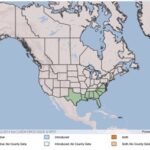Ludwigia pilosa
What is Hairy Water Primrose?
Physical Characteristics
Leaves:
- Linear or elliptical shaped
- 0.79-3.94 inches long
- 0.12-0.59 inches wide
- Leaf stalk 0.04-0.2 inches long
Flowers:
- 4 sepals
- 0.16-0.2 inches long
- No petals
Fruit:
- Dry seed pod
- Cube-shaped
- 0.12-0.16 inches long and thick
Seeds:
- Many seeded
- About 0.02 inches long
Stem:
- Branching
- Up to 4 feet tall
Where Does it Grow?
USDA, NRCS. The PLANTS Database (http://plants.usda.gov). National Plant Data Team, Greensboro, NC 27401-4901 USA.
Water primrose can be found in shallow marshes, ponds and ditches.
Pros and Cons of Water Primrose
Ducks and other waterfowl will consume the seeds of water primrose. Submerged portions of all aquatic plants provide habitats for many micro and macro invertebrates. These invertebrates in turn are used as food by fish and other wildlife species (e.g. amphibians, reptiles, ducks, etc). After aquatic plants die, their decomposition by bacteria and fungi provides food (called “detritus”) for many aquatic invertebrates.


